Line 6 Digital Wireless 91699TX94 900MHz ISM Band Digital Audio Transmitter User Manual UHF R User Guide
Line 6 Digital Wireless Inc. 900MHz ISM Band Digital Audio Transmitter UHF R User Guide
manual
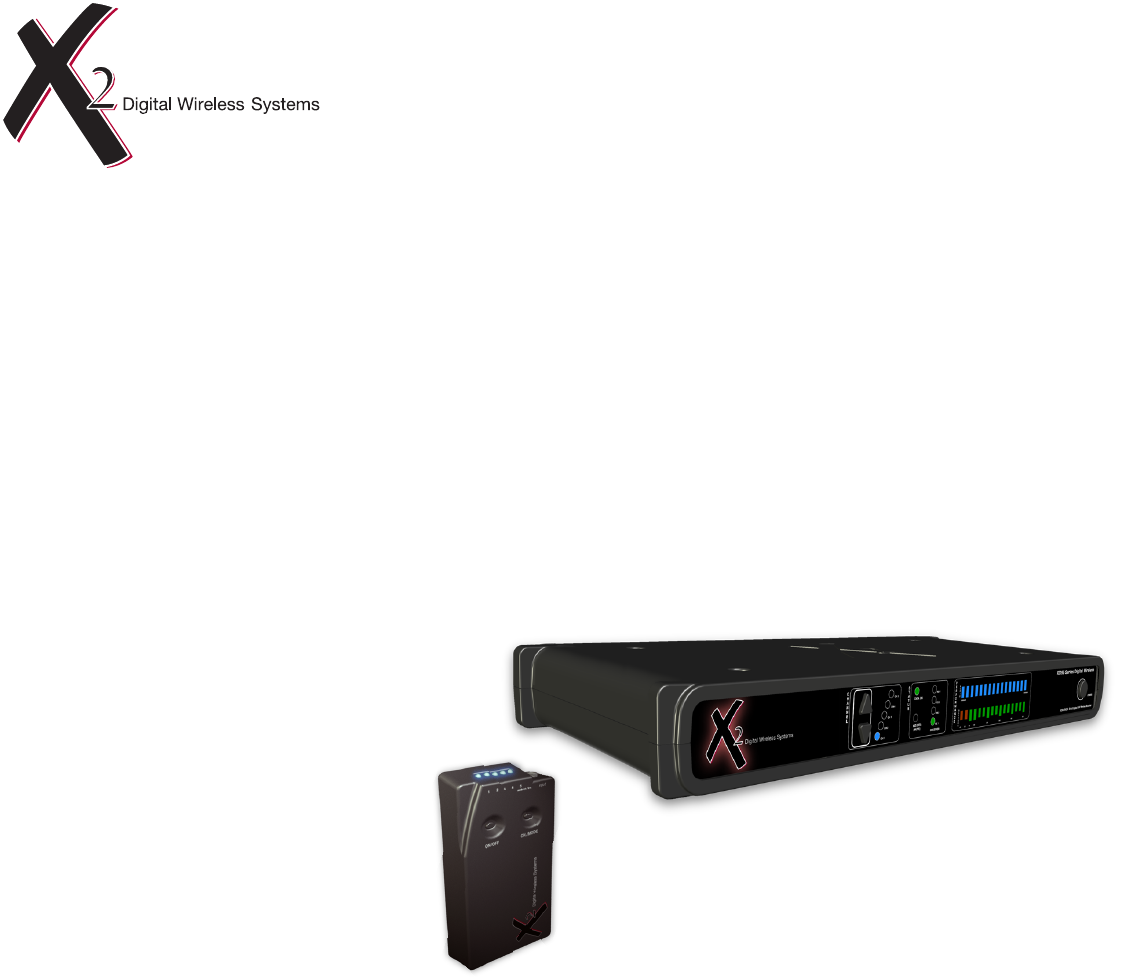
Digital UHF Wireless System
Model XDR-95
Users Guide
Includes instructions for single and multisystem operation
X2 Digital Wireless Systems
4630 Beloit Drive, Suite 20
Sacramento CA 95838 U.S.A.
Phone: (916) 779-1040
Fax: (916) 779-1041
Web Site
www.x2digitalwireless.com
Introduction to the XDR-95
About the XDR-95
System Components
XDR-95 System Features and Setup
XDR4 Digital UHF Receiver
XDT4 Digital UHF Transmitter
Battery Life Information
Troubleshooting
Optimizing Performance
Warranty and Service Information
Warranty Information
FCC Statement
Service Information
Specifications
Archictects’ and Engineers’ Specifications
1
1
1
2
2
3
3
4
4
5
5
5
5
6
7
Contents
Chapter 1
Chapter 2
Chapter 3
Chapter 4
Specifications
iii
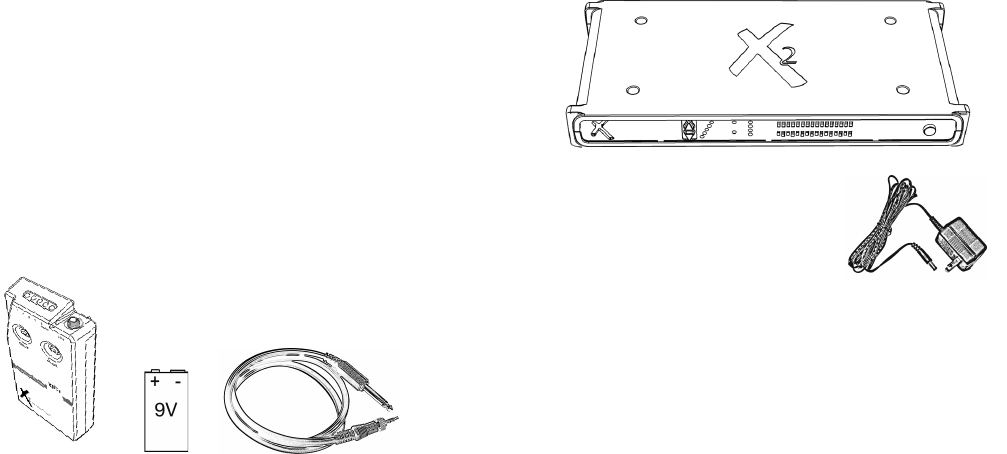
Introduction to the XDR-95 Digital UHF Wireless
Created specifically for performing and recording musicians who demand to be untethered
without compromising their sound, the XDR-95 24-bit digital wireless system delivers your
tone and performance with the sound and feel of a direct wire connection.
X2’s proprietary digital technology provides superior fidelity while the XDR-95’s receiver houses a micro-processor that selects the
digital data stream from among the four internal receivers to eliminate dropouts and interference including DTV and other digital signal
sources. You’ll enjoy the sound and performance of a direct wire connection free from compander ICs - and the associated ’pumping’
and ’breathing’ - that squash your tone, as well as other problems associated with analog wireless technology.
Operating the system is unlike any wireless you’ve tried before. Simply connect the transmitter to the source via the 1/8" threaded-collar
locking connector and the rack-mount receiver to your amplifier or mixer. Then power up making sure the transmitter and receiver are
set to the same channel. That’s it. You’re ready to go! No knobs to adjust and no antennas to loose or break mean you’re up and
running in the time it would take to connect a cable. For maximum performance range, attach the included 1/2 wave antenna or
optionally remote mount standard paddle antenna for even greater flexibility and range.
About the XDR-95 Digital Wireless System
All of this sound and performance is provided to you with an incredible feature set including:
• 24-bit digital converters yield 118 dB dynamic range to capture your most expressive performances
• Frequency Clear™ digital transmission means no FCC or DTV concerns
• Q-DiversityPLUS™ dual-frequency transmitters and receivers eliminates dropouts, multipathing and interference
• Five user-selectable channels (all five are fully compatible for simultaneous use)
• Full bandwidth frequency response 10 Hz - 20 kHz
• Balanced XLR and unbalanced 1/4” TRS outputs
• Real-time LEDs display critical performance indicators including operating channel, RF status, link status, audio level, transmitter
battery life - no menus to scroll through!
With the XDR-95 Digital UHF Wireless System you’ll have the freedom and sound to deliver your most expressive performance every
time without any hassles or complicated setup procedures.
To familiarize you with your new digital wireless system, we suggest that you read through this entire operation manual.
System Components
All system include:
• XDR4 Digital UHF receiver
• XAC4 (9V DC 500mA power supply for XDR4 - ASA120 type)
Bodypack systems include:
• XDT4 Digital UHF transmitter
• (1) 9V Alkaline Battery
• 1/4” to 1/8” locking connector instrument cable
1
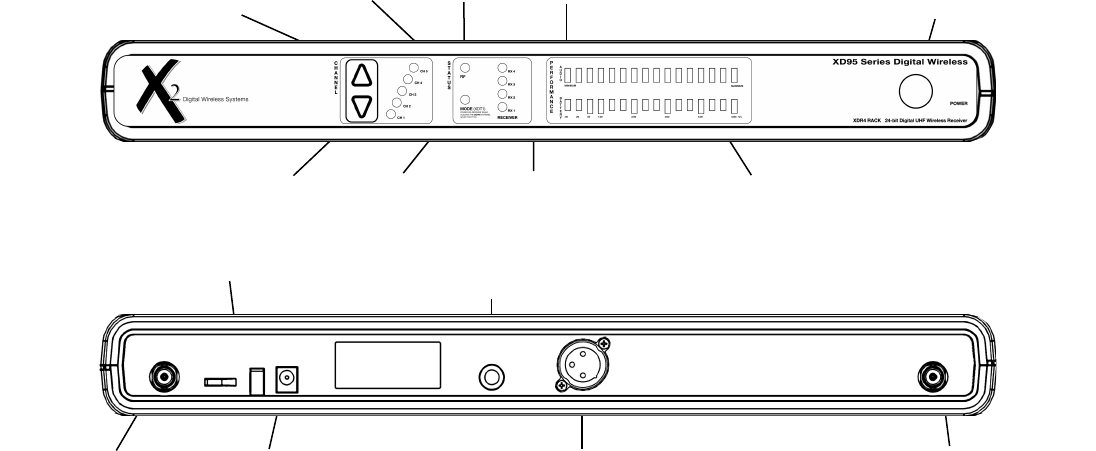
Receiver Controls and Connectors
Channel Up & Down buttons. Press the UP button to select the next channel. Press the DOWN button to select the previous channel.
Button sequence does not wrap around. For example, once CH5 is selected you must press the DOWN button four times to reach
CH1.
Channel LEDs. A blue LED will light indicating the currently selected channel of operation.
RF LED. A red LED will light indicating that an RF signal is present on the currently selected channel.
Mode LED. A red LED will light indicating that they receiver is currently operating in a backwards compatible mode to allow operation
with original XDT1 transmitters. Please note that while in this mode, the frequency response of the system is that of the original XDR1
receiver (10 Hz - 12 kHz). To enter this mode, power the unit off, press and hold the Channel DOWN button and power up. The unit will
remain in this mode until the power is cycled off then on again.
Receiver LEDs. A green LED will light indicating that the unit is receiving data on one of four internal receivers. The unit houses four
separate internal receivers, two of which include internal antenna meaning that the system will operate even without external antenna
attached. *Please note that range may be adversely affected without attaching the supplied 1/2 wave antenna.
Audio LEDs. Blue LEDs will light indicating the audio signal level. There is no need for a CLIP indicator as the system has greater
than 118 dB dynamic range and can accommodate input/output signals up to 6V peak-to-peak (approximately).
Battery LEDs. Green LEDs will light indicating remaining battery life in the transmitter. Each tall bar represents one-hour segments.
Each short bar represents 20 minute segments.
Power button. Press once to turn the unit on. Press again to turn the unit off.
Antenna A & B input connector (BNC). Diversity antenna inputs A and B. Connect the supplied 1/2 wave antenna for maximum
performance range. Antenna inputs ARE NOT DC biased.
Cable Grip. Thread the power supply cable into the CABLE GRIP to secure the connection.
Power input. DC socket for connection of mains unit, 9V 500 ma (supplied).
Instrument Out. This 1/4” unbalanced TRS output jack (1.8 kΩ) is voiced at the tip for instrument applications (gentle high-frequency
role off at 8 kHz approximates sound of a 15’ cable), and full bandwidth (10 Hz to 20 kHz) on the ring. Great for ‘tuner’ out or dual amp
setups.
Balanced Low Z. Balanced XLR, 600Ω, full-bandwidth output (10 Hz to 20 kHz).
Channel Up
button
Channel Down
button
Power supply Cable Grip Instrument Out
output 1/4” TRS jack - unbalanced, 1.8kΩ
Balanced Low Z
output XLR(F) - 600Ω
Antenna B
input connector (BNC)
Power Mains
input connector (ASA120 type)
Channel LEDs Audio LEDs
RF LED
Mode LED Receiver LEDs Battery LEDs
Power button
Antenna A
input connector (BNC)
2
Balanced Low Z
Instrument Out
9V DC 500ma
(center negative)
antenna B in antenna A in
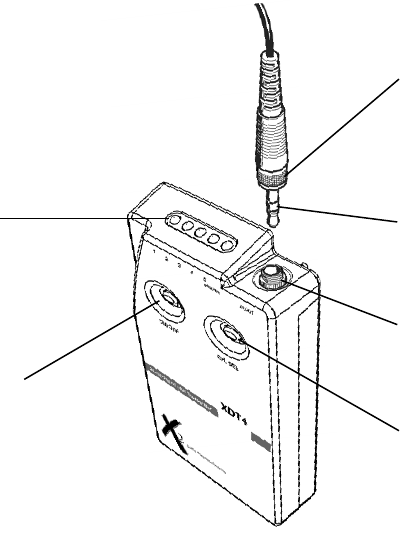
Transmitter Controls and Connectors
Power button. Press once to turn the unit on. Press again to turn the unit off.
Channel Select button. Press the CH SEL button to select the next channel. Button sequence will wrap around. For example, once
CH5 is selected you must press the CH SEL button one time to reach CH1. Receiver must be set to the same channel as the corre-
sponding transmitter in order to operate correctly.
LED Display. A blue LED will light indicating the currently selected channel of operation and a
red LED indicates remaining battery life
in one hour increments. When idle, these LEDs toggle continuously. During performance, blue LEDs indicate input level.
There is no
need for a CLIP indicator as the system has greater than 118 dB dynamic range and can accommodate input/output signals up to 6V
peak-to-peak (approximately).
Threaded Sleeve. Secure the 1/8” jack plug in place by screwing down the threaded sleeve onto the input jack socket threads and turn
approximately two times.
Jack Plug. For correct operation, the jack plug must be inserted all the way into the jack socket with the threaded sleeve securely
fastened to the threaded input jack socket.
Threaded Input Jack Socket. Make certain that a secure connection is made for trouble-free operation.
Instrument Input. The instrument input circuit is wired to the ring of the input jack plug and socket.
Microphone Input. The microphone input circuit is wired to the tip of the input jack plug and socket.
Battery Life. Fresh Alkaline batteries should last about ~6 hours in the XDT4. NiCad rechargeable batteries will only last about 3.5
hours. Standard batteries are not recommended. THE BATTERY HOUR DISPLAY WILL ONLY BE ACCURATE FOR ALKALINE
BATTERIES. The battery life is calculated inside the each component and displayed in 1 hour increments. Upon power up the battery
info will take about one minute to stabilize, the battery gauge is then accurate within + or - 15 min. You may use batteries until they are
completely drained without affecting the performance of the unit in any way.
Operation note: the system operates at unity gain meaning that the signal fed to the transmitter is produced identically at the receiver.
Therefore, there are no knobs to adjust or switches to change in order to achieve optimum signal levels.
Jack Plug -
Insert into jack socket.
Cable polarity: ring (+ instrument), sleeve (-), tip (+ mic)
Input
Threaded input jack socket
Channel Select button
LED Display -
A blue LED indicates channel,
red LED indicates battery life.
When idle, these LEDs toggle.
During performance, blue LEDs
indicate input level.
Power button
Threaded Sleeve -
Secure the 1/8” jack plug in
place by screwing down the
threaded sleeve onto the
socket threads approximately
two turns.
3

Troubleshooting
Power
Make certain that the transmitter and receiver are receiving sufficient power. The receiver requires 9V DC at 500 MA. The transmitter
requires 9V DC via alkaline 9V battery. Check the battery status indicator on the transmitter and replace if necessary.
Signal Source
Make certain that the source is operating as desired by checking source power, signal levels and connections. If necessary, bypass
digital wireless transmission and check the source directly.
Cables
Make certain that all connections and cables are in working order.
RF
Turn all known transmitters off. Check to see if the red RF LED on the receiver’s front panel is lit. If it is not lit, then the receiver is not
detecting the presence of RF signal on the currently selected channel. If it is lit, then the receiver is detecting the presence of unknown
RF signal. Check to see if any of the green Receiver LEDs are lit. If any are lit, then the receiver is detecting the presence of another
X2 transmitter set to the same channel. Locate this unit and either turn it off or switch channels. If none of the green Receiver LEDs
are lit, then the receiver is detecting confirmed RF signal from a source other than an X2 transmitter. Change the channel and repeat
these steps to locate a clear channel.
Issue
No sound.
Intermittent sound or distorted sound.
Lack of range.
Cause
Source malfunction. Improper connection. Multiple
transmitters are set to the same operating channel.
Transmitter has gone out of range. Transmitting
through metal wall. Unknown source of RF in local
area.
Improper or lack of antenna connection. Multiple
transmitters are set to the same operating channel.
Unknown source of RF in local area..
System not turned on. Source malfunction. Improper
connection or improper channel selection. Expired
battery.
Power, Signal Source, Cables or RF
Signal Source, Cables or RF
RF
See Solution...
RF Overload
This will usually not cause a problem unless you are using more than one system at the same time, in which case, it can become a
factor when maximum performance range is desired. For example, one performer is ~200 feet from their receiver and another
performer comes within one foot of the furthest performers’ receiver causing the furthest performers‘ signal to mute temporarily. This
can be avoided with proper planning. In any case, the offending transmitter’s signal will not ‘come through’ the other performer’s
equipment.
RF Interference
An X2 Digital transmission is not susceptible to interference in the traditional ‘analog’ wireless sense. An X2 receiver is will only pass
digital data that originated from an X2 transmitter set to the same operating channel. If this transmitter has a custom encryption
scheme, a standard X2 receiver will no longer be able to recognize or reproduce the signal. RF interference for X2 systems will only
become noticeable when a system’s range has been adversely affected or when the red RF indicator is lit without the desired
transmitter in use. In most cases, the system will still operate with an acceptable performance range even when RF interference is
present on your channel. Due to the anti-interference/anti-jamming technology of the XDR-95 system, you will likely never have a
performance negatively impacted by RF interference.
Increasing Range
For best results, maintain a line of sight between transmitter and receiver antennas.
Move receiver antennas away from metal objects or other sources of RF interference (such as CD players, computers, digital effects,
network switches, network cables, etcetera).
For multiple systems, make certain that each system is operating on it’s own separate channel.
4
Warranty and Service Information
Warranty Information
X2 will repair or replace any defective system within the first two years free of charge. X2 will cover 2-day return shipping costs in the
continental United States. This warranty is transferable, but does not cover abused systems. Terms and conditions subject to change
without notice. Please retain a copy of your dated sales receipt for proof of warranty status should repairs become necessary.
Warning:
Changes or modifications not expressly approved in writing by X2 Corporation may void the users authority to operate this equipment.
This device complies with part 15 of the FCC rules. Operation is subject to the following two conditions: (1) This device may not cause
harmful interference, and (2) this device must accept any interference received, including interference that may cause undesired
operation.
RF Exposure Statement: This transmitter must not be co-located or operated in conjunction with any other antenna or transmitter.
NOTE: This equipment has been tested and found to comply with the limits for a Class B digital device, pursuant to part 15 of the FCC
Rules. These limits are designed to provide reasonable protection against harmful interference in a residential installation. This equip-
ment generates, uses and can radiate radio frequency energy and, if not installed and used in accordance with the instructions, may
cause harmful interference to radio communications. However, there is no guarantee that interference will not occur in a particular
installation. If this equipment does cause harmful interference to radio or television reception, which can be determined by turning the
equipment off and on, the user is encouraged to try to correct the interference by one or more of the following measures:
—Reorient or relocate the receiving antenna.
—Increase the separation between the equipment and receiver.
—Connect the equipment into an outlet on a circuit different from that to which the receiver is connected.
—Consult the dealer or an experienced radio/ TV technician for help.
This Class B digital apparatus complies with Canadian ICES-003.
Cet appareil numerique de la classe B est conforme a la norme NMB-003 du Canada.
Refer All Servicing to X2
We believe that the XDR-95 is one of the most reliable wireless systems that can be made using current technology, and should provide
years of trouble-free use. However, should problems occur, DO NOT attempt to service the unit yourself. Service on this product
should only be performed by X2. THERE ARE NO USER SERVICEABLE PARTS INSIDE.
Obtaining Repair Service
Prior to contacting our service department, please take a moment to check over all of your connections, and make certain that you’ve
read this owners manual. Your X2 dealer may also be able to provide you with additional support. If the problem persists, call X2 at
(916) 779-1040 and request the customer service department. Talk your situation over with one of our technicians; if necessary, you will
be given a return authorization (RA) number and instructions on how to return the unit. All units must be shipped prepaid. COD
shipments will not be accepted. For prompt service, indicate the RA number on the shipping label. Tape a note on top of the unit
describing the problem. Include your name and phone number where X2 can contact you if necessary. Also, please include instruc-
tions on where you would like the system to be returned. X2 will pay for 2nd-day shipping back to you on any repair covered under the
terms of this warranty.
Service Address for customers in the USA:
X2 Digital Wireless Systems
4630 Beloit Drive, Suite 20
Sacramento, CA 95838
(916) 779-1040
5
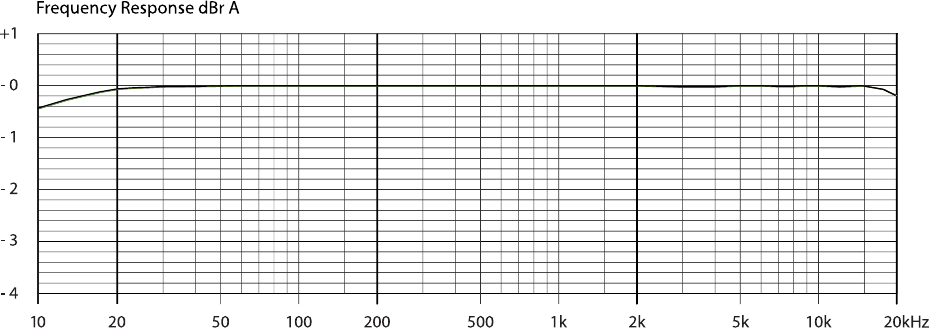
Specifications
Overall System Specifications
Transmission Format:
X2 proprietary digital audio transmission
A/D -D/A Conversion:
24-bit Delta Sigma, 128 times over sampling
Frequency Response:
10 Hz - 20 kHz
Audio Dynamic Range:
>118 dB
Distortion:
0.03% THD
RF Carrier Frequency:
902 MHz to 928 MHz, FSK, dual frequency transmission
Selectable Frequencies:
Five
RF Output Power:
10mw
Audio Output Level:
Unity gain with transmitter input
Polarity:
Positive voltage at input yields positive voltage at output
Transmission Range:
>300 feet line-of-sight (may vary due to local conditions)
FCC Approval:
Part 15 approved, no user-license required
Operating Temperature Range:
–18° to +57° C (0° to +135° F)
XDT4 Transmitter Specifications
Input Impedance:
1.3 MΩ
Connectors:
1/8" TRS locking connector, ring (+), sleeve (-), tip (open)
Controls:
Power On/Off, Channel Select
LED Display:
Five segment - Power On, Channel, Battery Life, Audio
Level Meter
Dimensions:
2.4" W x .66" D x 4" H
Battery Life:
Switching power supply, ~6 Hours (9V alkaline)
Weight:
.3 lbs (with 9V battery installed)
Housing:
Polycarbonate, impact tested to 300 lbs.
XDR4 Receiver Specifications
Output:
2.12V RMS (Unbalanced: 1.8kΩ)
Connectors:
1/4" Unbalanced TRS output 1.8kΩ impedance, tip=
instrument voicing, ring= full bandwidth, sleeve= ground
XLR Balanced 600Ω
LED Display:
Power On, RF, Channel, Diversity, Battery Life, Audio Level
Meter
Controls:
Power On/Off, Channel UP and Down
Dimensions:
XDR4: 44.5 mm H x 411.45 mm W x 190.5 mm D
(1.75 x 16.2 x 7.5 in.).
Power Requirements:
9V DC 500mA via included AC/DC adapter
Weight:
2.5 lbs (with rack hardware and antenna installed)
Housing:
Polycarbonate, impact tested to 300 lbs.
NOTE: This Radio equipment is intended for use in musical professional entertainment and similar applications.
6
Additional Information
Architects' and Engineers' Specifications
The wireless system shall utilize digital conversion with a dynamic range of greater than 117 dB dynamic range without the use of
compander ICs, and operate in the UHF band between 902 MHz and 928 MHz for operation in North and South America. The system
shall transmit a digital representation of the audio signal over two separate RF frequencies that include a unique digital code sequence
that identifies the transmission to the receiver thus locking out all other sources of interference without the need of squelch circuitry.
The system shall include the option of changing the operating frequencies enabling up to 5 systems to operate simultaneously in the
same location. All operating frequencies shall be preset and compatible to ensure that multiple systems in use do not interfere with one
another.
All transmitters shall be powered by a single 9 volt battery and shall have a power on/off button as well as a channel select button. The
bodypack will have an LED display indicating power status, battery status, operating channel and audio level. Available transmitters
shall include: a body pack for use with electric guitars, basses and other electric instruments, and lavaliere and headset microphones
for vocals. The transmitter shall have a DC/DC converter to ensure consistent performance, even if battery voltages change.
The receiver shall have two user-selectable channel selection buttons, one for ‘next’ channel and one for ‘previous’ channel. The
receiver LED display shall indicate the current operating channel, RF present, Diversity status, Audio Level, remaining Battery Level in
the transmitter with a resolution to within 20 minute increments being preferred.
The system shall use technology such as Q-diversityPLUS to maximize RF performance, and TruDIGITAL to eliminate interference,
audio artifacts and unwanted noise. The receiver shall include four Receiver LEDs (one for each internal receiver), automatically
indicating which internal receiver is currently in use. The receiver shall not have a volume control and shall produce the exact signal
captured at the input of the transmitter at unity gain. The system shall be capable of handling an input and output signal of up to 6 volts
peak-to-peak without the use of compander ICs.
The system shall be the X2 XDR-95 Digital Wireless System.
7